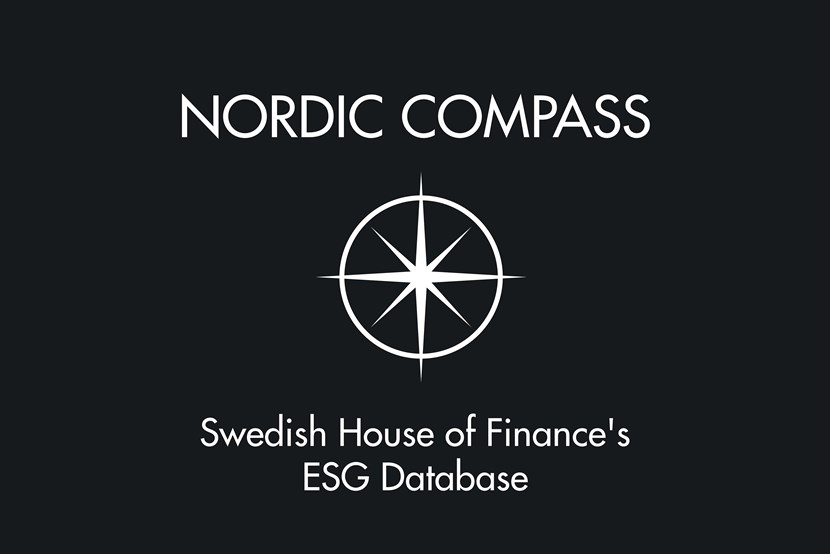Nordic Compass, Swedish House of Finance's ESG Database
Nordic Compass, Swedish House of Finance's ESG Database, is a database with Environmental, Social and Governance data (ESG) on 400+ publicly traded Nordic large-cap and mid-cap companies since 2013. ESG data is collected from company reporting and disclosures by a data collection team. It is then structured and harmonized. The data set includes ISIN code and organization number that links to other data sets.

Purpose
The purpose of the Nordic Compass is to collect, maintain and distribute detailed, firm-level ESG-data targeted to researchers all over Sweden.
History
The Nordic Compass database was intitiated in 2014 in a effort to manually collect and compile Nordic firm-level ESG-data. The motivations behind collecting this data twofold. First, firm-level information on sustainability measures is scarce and particularly for smaller firms, such as those in the Nordic stock market. Second, many of the available data sources also produce rankings that are not always consistent across different data base vendors, adding to the complexity of evaluating firms in the three distinct ESG dimensions separately. Raw, individual, firm-level data for specific variables of interest is widely unavailable or expensive for researchers to use. Nordic Compass aims to fill this gap. The project is funded by a grant from Vinnova for the period 2019 to 2022.
Method
The data collection is made manually during the summer time each year by a group of research analysts, downloading the annual reports for the preceding year of firms in the sample. As the sample is expanded, we keep firms already in the sample to the extent possible. The overall coverage across firm-years is:
| Year | Coverage (no. of firms) |
|
|---|---|---|
| 2014 | 252 | |
| 2015 | 371 | |
| 2016 | 415 | |
| 2017 | 481 | |
| 2018 | 451 | |
| 2019 | 487 | |
| 2020 | 493 | |
| 2021 | 439 | |
| 2022 | 422 | |
| 2023 | 501 |
Sample
The initial sample covers publicly-traded large-cap companies with a market value exceeding EUR 1 billion listed on the NASDAQ-OMX Nordic exchange. In 2015, the universe was further expanded to cover both large-cap and mid-cap companies (a market value between EUR 150 million and EUR 1 billion) listed on NASDAQ-OMX Nordic and Oslo Bors.To data collection base year 2023, the universe is based on unique firm observations in the database since 2014.
Data
The data is organized in one panel. There are around 111 variables that cover the Environmental, Social, and Governance (ESG) topics. The definition of the fields are available on the homepage of the data set in the document “Field definitions”. The number of matrices further expanded to include around 20 more detailed matrices on executive compensation in 2019 with a collaboration with the Nordic Investor Service (an independent corporate governance advisory firm based in Stockholm). The firms contain identifiers such as organization number, ISIN-codes, Finabas ID:s and GVKEY for matching across different data sets.
Analysts
The analysts for data collection are hired every summer, mainly from master students of Stockholm School of Economics and Royal Institute of Technology even if the positions are open to everyone who wants to apply. Each analyst manages the data collection and consolidation for approximately 80 companies. The data collection is based on established rules and guidelines outlined in the collection manual and data definitions originally provided by Resility AB. The analysts are subject to training by experienced analysts and supported during the data collection phase by a small staff at the Swedish House of Finance.
Quality
The research we do is based on publicly available information such as annual reports, sustainability reports, company websites as well as factsheets provided by NASDAQ-OMX Nordic. Since the analysts are mainly proficient in English and Swedish, the data quality based on Norwegian, Danish, and Icelandic report may be poorer. For these circumstances, the analysts will use translation software. An analyst is encouraged to label the pending data points for later discussion within the team and a further check by an experienced analyst. In a second step, the data is verified in batches to detect missing values and outliers.
Users are encouraged to report suspected mistakes or post questions via the
portal.
Link opens in a new page.

